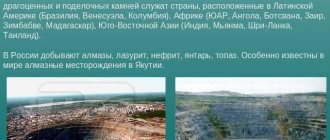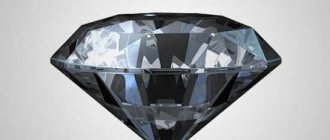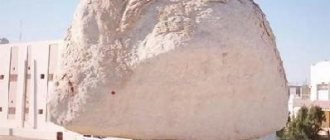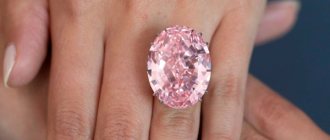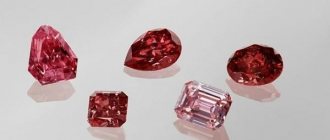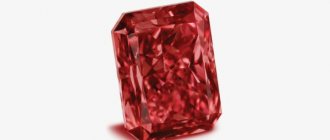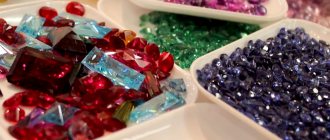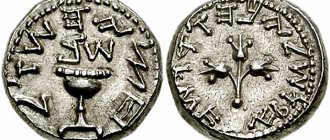The most famous stones in the world
There are a huge number of precious stones in the world. For many people they are a collector's item and a true passion.
However, only some of these treasures have, like people, names.
"ORLOV" OR "THE GREAT MOGHL"
In 1773, Gregory presented the Empress with one of the most famous diamonds in the world, which eventually received the name “Orlov”.
According to ancient legend, the stone represented the third eye of God Shiva and was located on the forehead of a statue of the god in India for many centuries. Once it was stolen, then it was cut and became an item of trade. Many years later, the diamond ended up in Russia. Orlov bought it for 400 thousand rubles. The stone has a beautiful bluish-greenish tint and weighs 194.8 carats. The rose cut, which has 180 facets, is stunning. The diamond became the main decoration of the scepter of the Russian tsars. Today it is kept in the Kremlin’s diamond fund, inlaid into the imperial scepter. It is the largest diamond from the collection of historical stones of the Diamond Fund of the Russian Federation.
The legend of the theft of this diamond from the Indian temple was used by Wilkie Collins in his “Moonstone”. It is believed that if the ancient cutter had been more skilled, he would have divided the stone into several parts
Pearls
The Pearl of Allah is the largest in the history of mankind . According to legend, it was grown for many years in China, transplanted from one shell to another. When the pearl was transported by sea, the ship was caught in a storm and crashed. The jewel fell into the open sea and lay there until 1934. She was discovered by a Filipino pearl fisherman. The weight of the “pearl” is 6.4 kg. It is covered with grooves and irregularities. Some see the face of Allah in the drawing of a pearl, another outline of the human brain.
A pearl from the collection of banker Henri Hope is named after him . It has a bizarre pear shape and weighs almost 90 grams. The large side of the Hope Pearl is painted bronze, gradually turning white towards the top. The top is decorated with a red gold crown inlaid with precious stones.
"SHAH"
Found in India in the 15th century. Has three engraved inscriptions about the owners of the stone. The diamond is not cut, but only polished. It is believed that this particular stone was presented to the Russian government for the murder of A.S. Griboyedov, although this fact is not confirmed.
This is the second largest diamond in Russia after the Orlov, and is stored in the Diamond Fund of the Russian Federation. On three well-polished surfaces of the diamond there are inscriptions carved: the names of the three rulers of Persia. Currently, the stone weighs 88.7 carats, but it is believed that before processing it weighed about 95. Mineralogist and geochemist A.E., who examined the stone in 1922, Fersman noted the impeccable transparency of the stone. The Shah diamond has a yellowish color with brown inclusions.
By 1591, the diamond belonged to the ruler of one of the Muslim states in India - Burhan II. The large transparent stone captured the imagination of the ruler; it was he who ordered the first inscription to be engraved on the diamond, calling himself “Lord of Order.” In 1592, Shah Akbar, who conquered this state, appropriated the stone. So a large diamond became the regalia of the Great Mongols. For about forty years the stone was in the treasury until it was noticed by Akbar’s grandson, Shah Jihan, who further exalted the Mongol state. Having dealt with all the contenders for the throne, Jihan began to rule. We owe the emergence of the Taj Mahal - one of the wonders of the world - to him: after the death of his wife, he ordered the best craftsmen to build a mausoleum, which will not be equal in the entire Universe. Jihan gave the order to carve the second inscription on the stone: his name and the dates of his reign. This time, the unknown master used all the graphic capabilities of the language: now the inscription looked like an ornate, whimsical pattern, and not like ordinary text. Fath Ali Shah ordered the third inscription on the stone in 1827 in honor of the thirtieth anniversary of his reign. The writing on the last free face of the diamond amazes with talent, perfection of work and intricate imagination.
Photos from open sources
The most expensive stones in the world. Interesting stories
"Virgin's Rainbow"
Precious Virgin Rainbow opal is one of the most beautiful stones in the world. Opal, endowed with a large number of colors. Found in Australia in 2003. It shimmers with all known colors and glows in the dark.
The stone is the size of an index finger, and its age is estimated at millions of years - that’s how long it took Mother Nature to compress and transform it.
"Virgin's Rainbow", according to experts, is the most perfect and expensive opal that has ever been found.
The current price is $1 million.
"Josephine's Blue Moon"
Blue diamond size 12.3 carats. The stone combines the unique properties of blue color and, at the same time, pure transparency and purity. The diamond from which the diamond is made was found in January 2014 at the Cullinan mine in South Africa.
Sold at Sotheby's auction for $48.4 million to Hong Kong entrepreneur Joseph Lau. At the time of the sale, which took place on November 11, 2015, this was the highest price a diamond had ever fetched at auction.
The diamond was given to his 7-year-old daughter. And her name was added to the original name of the stone “Blue Moon”.
"Cullinan" or "Star of Africa"
The largest diamond found in the world. Its weight was 3106.75 carats (621.35 grams).
The famous diamond was found by accident. Fortune fell on the Premier mine in the Transvaal, near the city of Pretoria in what is now South Africa. On January 25, 1905, mine manager Frederick Wells made his nightly inspection of the mine. When he descended to a depth of five meters, in the reflections of the setting sun in the wall above his head, he noticed a flash of light. At first, Frederick thought that one of the miners was joking and stuck a piece of glass into the wall of the mine. However, he still came closer and, using a pocketknife, extracted from the rock a crystal about ten centimeters long, six centimeters wide and seven centimeters high.
The discovery of the world's largest diamond became a real sensation. It not only aroused public interest, but also gave a powerful impetus to the development of the diamond mining industry. Particularly exciting was the fact that part of the diamond from which Cullinan had broken off still remained in the rock.
Even with modern technology, cutting diamonds is a complex business. At the beginning of the 20th century, turning a diamond into a high-quality diamond was practically an art. Several months were spent studying the diamond. The examination showed the presence of cracks and small internal defects, which made it impossible to cut it into one diamond. Also, in the center of the stone there was a dark spot surrounded by a lighter area. This indicated the presence of internal tension inside the diamond, which significantly complicated the work. The actual cutting of the Cullinan began on February 10, 1908. The work was carried out by the head and owner of the company, Joseph Asher. A cut was made in the stone, half an inch deep (about 1.25 cm), into which a specially designed knife was inserted. The blow to the knife split the diamond into two parts, exactly the dark spot, as planned.
Now this stone does not exist in its entirety; it has been crushed into large and small diamonds. The total mass of all stones received is 1063 carats, and their value was more than 2 billion dollars.
"Zoe's Blue Diamond"
In 2014, the Rachel Mellon collection was auctioned at Sotheby's. Among this collection was a beautiful large blue diamond. Its provenance is unknown.
The same billionaire from China who bought a blue diamond for Josephine bought a second blue diamond, but for a different daughter, Zoe. The size of this diamond is 10 carats, the price is 33 million dollars.
"Graff Pink"
The diamond, before being auctioned at Sotheby's Geneva in 2010, belonged to Harry Winston. A magnificent stone of intense fancy pink color, 24.78 carats. The diamond's new owner, Lawrence Graff, paid $46.2 million for it. The most beautiful diamond, which had not previously had its own name, was named after the owner.
"Apollo and Artemis"
The most expensive earrings in the world.
Apollo Blue is a 14.54 carat bright blue diamond. Artemis Pink is a 16-carat hot pink diamond.
The Gemological Institute of America classifies the bluestone as Type IIb, which is awarded to less than 1% of diamonds worldwide.
The pink stone is rated IIa by the GIA, another category that characterizes the purest diamonds.
In May 2022, the diamonds were auctioned at Sotheby's. "Artemis" - for $15.3 million, and "Apollo" - for $42.1 million.
"Emerald of Bahia"
The largest single emerald nugget in the history of mankind. The total weight of the gemstone is 1.9 million carats. It was found in 2000 in the state of Bahia, Brazil. This gem was stolen many times in different parts of the world, such as Las Vegas, then it was discovered and disappeared again in New Orleans.
Was the most wanted item.
It has now been found and is undergoing legal battle in California, which is one of the largest property rights lawsuits in the history of the state. There are eight people claiming ownership of the emerald. One man says he paid a collective of Brazilian miners $60,000 for the gem, while another says he traded $1.3 million worth of diamonds for the emerald. It remains unclear what will happen to the huge gem if no one can prove their right to own the emerald.
Estimated at 400 million dollars.
"Star of Adam"
A 1,404-carat star sapphire was recently found on the island of Sri Lanka. The previous record holder was 1,395 carats, only 9 carats less. The gemstone received this name because, according to Muslim beliefs, when Adam left the Garden of Eden, he ended up in Sri Lanka. The owner remains anonymous. The price is approximate, because There has not been any bidding for it yet, but the initial price, according to experts, could start at $100 million.
Diamond
Many people believe that the most expensive stones in the world are diamonds. But it is not so. These gems also have their own kings.
There are many varieties of diamonds in the world, and not all of them are transparent. Diamonds in yellow, blue, cognac, and black shades are striking in their beauty. For each variety, different types of cuts are used, emphasizing the natural beauty of the stone.
There are several diamond deposits in the world. Experts have found that the formation of this unique gem sometimes takes millions of years. And some diamonds came to our planet from space, probably arriving in the bodies of meteorites.
The cost of diamonds depends on two parameters: the natural characteristics of the nugget and the quality of its cut. But it’s hardly worth expecting to buy a diamond for less than $15,000 per carat. Even very tiny stones of 0.1-0.2 carats are expensive - they are used in jewelry both to emphasize the beauty of other stones and as independent players.
Granite deposits
Now granite rocks occur close to the surface of the earth's crust and less often on the ocean floor. Their formation occurred throughout the history of the earth. The oldest samples date back to 3.8 billion years.
Initially, feldspar lay far from the surface, at a depth of 10-15 km. But gradually the sedimentary rocks were eroded and weathered, due to which the granite slabs were exposed.
Granite makes up 77% of all igneous rocks near the earth's surface. Its deposits are different. These are small veins of 1-10 meters or huge layers that make up entire granite belts. The maximum depth of such formations is unknown. For example, in Peru, a layer of granite is exposed for 4 km, but this is not the limit.
Granite development is currently underway in many countries. The most famous:
- In Russia, these are the Khabarovsk Territory, Primorye, Transbaikalia, and the Urals. White, gray and brown stones are mined here. In the Leningrad region, Karelia, and on the Kola Peninsula there are deposits of pink, red and yellow stone. Gray-pink granite is found in the Murmansk region.
- Ukraine is famous for red stone.
- In Central Asia: Kazakhstan, Tajikistan, Uzbekistan. Rare green-blue granite is mined here.
- Europe: Bulgaria, Portugal, France, Scandinavian countries. Spain and Sardinia are famous for their light pink granite.
- China, India, Sri Lanka.
- Africa.
- North America.
Australia is rich in granite; there are deposits of blue granite here, but the deposits have not been fully explored and stone mining has not been developed.
Ruby
The stone, which has received the attention of crowned persons since ancient times, has an ancient history. Rubies are relatives of sapphires. They were valued by the ancient Greeks and Romans, and in India from time immemorial it was believed that rubies have magical properties. Stones are mined on all continents except Antarctica. Asian stones, the color of which is called “pigeon blood,” are considered the most valuable.
The most expensive ruby is a stone weighing 25.5 carats. The buyer paid $30 million for it, and so far this case is considered a record.
Emeralds
The Devonshire emerald is one of the largest and most famous stones. It is not cut and has not undergone any jewelry processing. At one end of the crystal there are remains of calcite from which the gem was extracted. Its weight is almost 1400 carats, it has the shape of a hexagonal prism. The Duke of Devonshire Emerald is a perfect emerald color and is an excellent example of Colombian gems.
The history of the Mughal emerald goes back more than 300 years and weighs 217 carats. The stone has not only jewelry, but also cultural and historical value. Islamic prayers and ancient ornaments are carved on its edges. For a long time, the crystal was owned by a collector, and in 2001 it was sold for $2.2 million, presumably to the United Arab Emirates.
Applications of granite
Granite is not affected by acids and salts, so this stone can be used in the chemical industry. The low coefficient of water absorption makes granite an indispensable material for cladding pools, fountains, and embankments. Due to the frost resistance of granite, it is a material for exterior decoration of buildings. Granite wears out little, so it is used in interior decoration of high-traffic areas, and it is also a material for road construction. Here are just some examples of its use:
- columns;
- monuments;
- parapets;
- paving stones, curbs;
- floor tiles;
- wall panels;
- steps of stairs;
- window sills;
- countertops;
- vases;
- cornices;
- parts of production machines;
- millstones;
- bases of high-precision instruments;
- material for railway embankments.
Granite is susceptible to weathering and melts at temperatures above 700 degrees. But meanwhile, many granite architectural monuments from thousands of years ago have reached us: ancient Egyptian, ancient Roman, Greek buildings. Many have not survived to this day, destroyed by wars and natural disasters.
An example of thousand-year-old granite structures:
- Stonehenge. Its stones weigh more than 50 tons;
- the obelisk of Hatshepsut, weighing 343 tons;
- Spanish monastery of Escorial.
During the reign of Peter I, the mining of jasper, malachite, jade and other stones reached its peak. During the construction of St. Petersburg, granite was mainly used. “The Neva is dressed in granite.” These are the buildings of the Academy of Arts, the Stock Exchange, the Admiralty, and St. Isaac's Cathedral.
Granite can be mined in huge multi-ton masses. For example, the pedestal of the Bronze Horseman statue in its original form weighed 2,000 tons, or the Alexandrian Column, which in its raw form was a stone more than 30 meters high.
Physicochemical characteristics
Translated from Latin, “granite” means “grain”. This describes its structure. Granite is actually made up of grains of various minerals. In modern geology, granite is usually classified as a mineral with the following composition:
- the share of feldspars is 60% of the rock;
- quartz – 30%;
- mica – 5-10%.
Sometimes, along with feldspar, granite contains hornblende, biotite, and muscovite. Depending on the composition, the color of granite may vary. Most often it is a gray stone with darker inclusions, but red, brown, pink, yellow, and green granite are found. Quartz in granite looks like glassy transparent grains from 2 to 25 mm. At a certain viewing angle, they give the stone a shimmering shine. Less common are varieties with inclusions of bluish quartz, which colors the entire mass of feldspar.
Characteristics of the stone:
| Density g/cm3 | 3,17 |
| Mohs hardness scale | 6 – 7 |
| Water absorption | 0,2% |
| Dry compressive strength | 604 kg/cm2 |
| When wet | 550 kg/cm2 |
Due to its characteristics and prevalence in nature, granite is widely used in construction and manufacturing. A large number of varieties gives room for the imagination of designers.
How granite is formed
This issue has been the subject of debate for a long time.
Development of theories:
- In the 18th century, it was believed that granite was a sedimentation of crystals on the seabed.
- In the 19th century, they began to believe that granite is magma, which, rising to the surface, captures and sinteres other minerals, cools and crystallizes.
- In the 20th century, another theory was added to the previous one. Granite is the result of hot springs that erode and transform rocks. Some components are washed out, others crystallize and sinter.
Now the last two theories are being developed. It is generally accepted that they both have a right to exist. Some of the granite massifs were formed magmatically, some by granitization.
